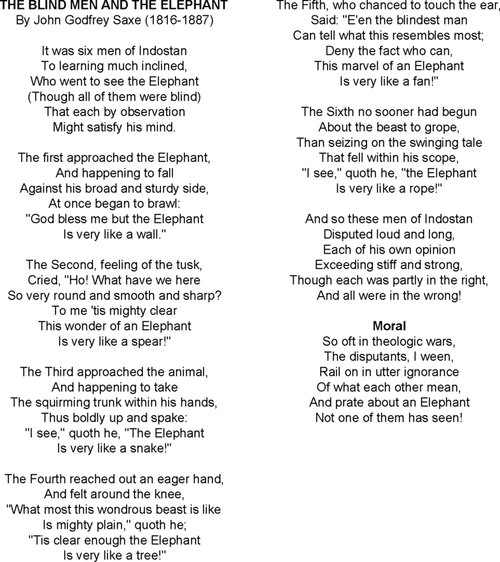Section 18.6. Many Good Ways
18.6. Many Good WaysIn their fascinating book Strategy Safari (Free Press), Henry Mintzberg, Bruce Ahlstrand, and Joseph Lampel approach the subject of business strategy in a manner we as information architects would do well to emulate. The book begins with the fable of "The Blind Men and the Elephant," (Figure 18-5), which they note is often referred to but seldom known. We decided to follow their lead. Figure 18-5. The Blind Men and the Elephant The authors of Strategy Safari proclaim, "We are the blind people and strategy formation is our elephant. Since no one has had the vision to see the entire beast, everyone has grabbed hold of some part or other and 'railed on in utter ignorance' about the rest." Swap "strategy formation" with "information architecture," and you've just described many of the heated debates at our conferences and on our discussion lists. Strategy Safari extends the philosophy of "many good ways" by describing 10 schools of thought within the business strategy field:
The authors describe an evolution over the past 50 years from the top-down, highly centralized design and planning schools toward the bottom-up, entrepreneurial learning and cultural schools. In today's information economy, there's greater recognition that thinking can't be isolated to the CEO and an elite team of corporate strategists. Knowledge workers must play a role in strategy formation. The doers must also be thinkers, and the plan must be informed by the practice. This evolution is driven by advances in information technology, increased maturity in business management theory, a better-educated workforce, and changing social dynamics. The authors note that during this 50-year evolution, the business community has desperately embraced each new school as the "one best way," only to abandon it when something better came along. They explain that just like the blind men, each school is partly right and partly wrong. None deserves a full embrace, but none should be completely thrown aside either. |
EAN: 2147483647
Pages: 194